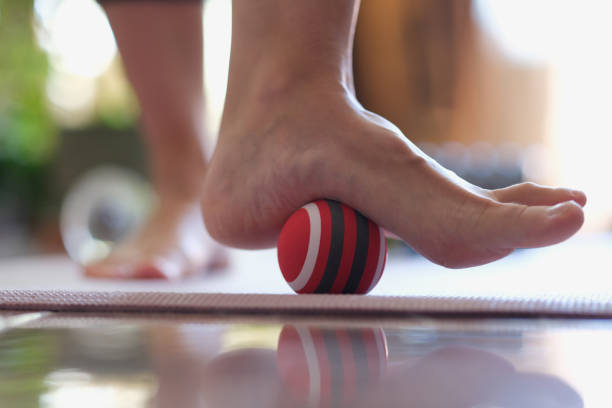Plantar Fasciitis: Your guide pain relief

Lets chat
Howdy y’all Dr. B, your friendly neighborhood chiropractor, and this week, I’m here to shed some light on a common and often quite bothersome foot condition – plantar fasciitis. Whether you’re an athlete, a busy parent, or anyone who enjoys being on their feet, understanding what plantar fasciitis is and how to manage it can make a significant difference in your daily life.
In this blog post, I’ll cover the basics, from what plantar fasciitis is to its causes and, most importantly, five effective ways to resolve both its symptoms and underlying causes.
What is Plantar Fasciitis?
Plantar fasciitis is a common foot condition that affects the plantar fascia, a thick band of tissue that runs along the bottom of your foot, connecting your heel bone to your toes. This essential tissue provides support to the arch of your foot and plays a crucial role in your ability to walk and stand. When the plantar fascia becomes irritated or inflamed, it results in the painful condition we call plantar fasciitis.
Presenting Symptoms
Heel Pain: The hallmark symptom of plantar fasciitis is often a sharp, stabbing pain in the heel, particularly when you take your first steps in the morning or after prolonged periods of rest. This pain can also intensify after long periods of standing or physical activity.

Arch Pain: Many individuals with plantar fasciitis experience pain or discomfort in the arch of the foot, as the plantar fascia supports this area. This pain may be dull or sharp and can affect the entire arch or be more localized.
Stiffness: Stiffness in the affected foot is another common symptom. You may notice that your foot feels rigid and less flexible, especially during those initial steps after resting.
Swelling: In some cases, mild swelling can occur around the heel and arch, contributing to discomfort.
Discomfort Over Time: Left untreated, plantar fasciitis can lead to chronic pain, making everyday activities like walking, standing, or participating in physical activities challenging
What are some causes of Plantar Fasciitis?
Understanding the causes of plantar fasciitis is essential in finding effective ways to manage and resolve the condition. Several factors can contribute to the development of plantar fasciitis:
Overuse and Repetitive Stress: One of the primary causes of plantar fasciitis is excessive stress and strain on the plantar fascia. This often results from activities that involve repetitive impact, such as running, jogging, or standing for extended periods.
Improper Footwear: Wearing shoes with inadequate arch support or improper cushioning can increase your risk of developing plantar fasciitis. High heels and flip-flops are common culprits.
Biomechanical Issues: Abnormal foot mechanics, such as flat feet or high arches, can put extra stress on the plantar fascia, leading to inflammation and pain.
Excess Weight: Carrying excess body weight increases the strain on your feet, including the plantar fascia. This can contribute to the development and persistence of plantar fasciitis.
Age and Activity Level: Plantar fasciitis is more common in middle-aged individuals, but it can affect people of all ages. Additionally, sudden increases in activity levels or changes in exercise routines can trigger symptoms.
How to resolve / or alleviate Plantar Fasciitis?
Active Solutions:
Stretching and Strengthening Exercises: Gentle stretching exercises can help alleviate tension in the plantar fascia and surrounding muscles. Try exercises like calf stretches, Achilles tendon stretches, and towel curls to maintain flexibility and strength in your feet and lower legs. Regularly performing these exercises can reduce the risk of recurrence. It is important to understand that stretching and mobility each have their own special purpose. For the best results, I recommend to introduce a combination of both practices.

Chiropractic Care: Chiropractic adjustments can be a valuable part of a comprehensive plantar fasciitis treatment plan. A chiropractor can assess your musculoskeletal alignment, including your lower back, hips, and feet. Misalignments in these areas can contribute to foot problems, and chiropractic adjustments can help restore proper alignment, reducing stress on the plantar fascia. The proper alignment of the bones in your feet to your hips and up through your spine help to not only alleviate tension on your musculo-skeletal system, but it aids in allowing for proper biomechanics of your body; thus ensuring more efficiency in movement.
Physical Therapy: Physical therapists specialize in addressing musculoskeletal issues and can provide targeted exercises and manual techniques to improve foot function and alleviate pain. They can also teach you how to maintain proper biomechanics to prevent re-injury.

Myofascial Release / Trigger Point Therapy / Massage / Foam Rolling: Releasing pressure in fascial and musculo system has shown to have significant success in reducing not only the symptoms of plantar fasciitis, but actually increasing the range of motion, flexibility, as well as the biomechanics of movement in the feet, knees, and hips. A 2014 study tested the effectiveness of Myofascial Release (MFR) on plantar fasciitis; the results determined that myofascial release technique was more effective than non treatment.
“The patients in the MFR group reported a 72.4% reduction in their pain and functional disability as shown in the FFI score in Week 4, which persisted as 60.6% in the follow-up at Week 12 compared to the baseline.“
Ajimsha, M. S., Binsu, D., and Chithra, S. “Effectiveness of Myofascial Release in the Management of Plantar Heel Pain: A Randomized Controlled Trial.” The Foot, vol. 24, no. 2, 2014, pp. 66-71. ISSN 0958-2592.
What is the best myofascial tools to use?
I am often asked the question, “so doc, Where do I get what I need? And what do I actually need to get”? The truth is there are numerous options to choose from, some better than others to be honest. I could walk you through and endless list of various therapy balls, foam rollers, and countless myofascial tools. But to make things simple, here are is what I recommend as a fundamental “therapy kit”:

High-Density Round Foam Roller:
This is as simple as you can get, and there is nothing wrong with that. This foam roller will allow you to apply a deep release of muscle tightness, and inflammation, while improving joint range of motion. These will come in a multiple sizes, shapes, colors, and textures. I have seen the most benefit in my patients, with an 18″ firm, high-density one. CLICK HERE TO PURCHASE

Massage Balls:
This option carries a bit more specificity to reduce muscle tension, release trigger points, and increasing joint range of motion. I am a fan of this product because it offers three different sizes, and the purpose of this allows you to put the ball in very specific locations or in smaller locations. If you are looking for a direct resolution to something like “Plantar Fasciitis” this is my recommendation . CLICK HERE TO PURCHASE
Passive Solutions:
Rest: One of the first steps in managing plantar fasciitis is to give your feet a break. Reducing or modifying activities that exacerbate your symptoms, such as high-impact exercises, can help the healing process. One of the easiest ways to reduce inflammation, and alleviate further stress on our feet is to simply elevate and rest.
Proper Footwear: Investing in the right pair of shoes can make a world of difference in managing plantar fasciitis. Look for shoes with good arch support, cushioning, and shock absorption. Orthotic inserts or custom-made orthotics may also be beneficial in providing additional support and alignment for your feet. This step is extremely vital for those that are active, aka my runners and “weekend warriors”. For this I highly recommend visiting your local run shop to meet with a specialists to determine what shoe will best optimally work with your goals and feet.
Night Splints: Wearing a night splint can help keep the plantar fascia stretched during sleep, reducing morning pain.
Supportive Insoles: In addition to proper footwear, using over-the-counter or custom-made orthotic insoles can provide extra support and comfort.
In conclusion, plantar fasciitis is a challenging condition, but with the right approach, you can successfully manage and even resolve it. Remember that consistency and early intervention of treatment is key, and it may take time to see significant improvement. Always consult with a healthcare professional, like your chiropractor, for personalized guidance and treatment options tailored to your specific needs. Don’t let plantar fasciitis hold you back from enjoying an active, pain-free life!
Best regards,


Dr. Brandon Pounds DC, CES, PES is the owner of Advanced Health Chiropractic. He is a board certified and licensed chiropractor in Texas. Click on the link to view his Curriculum Vitae

Leave a Reply